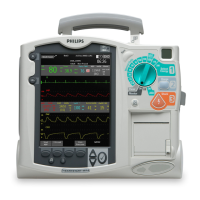Shift Checklist 19 Maintenance
221
Shift Checklist (page 2)
HeartStart MRx Weekly Shock Test
Do one of the following at least once a week to verify the ability to deliver defibrillation therapy:
Operational check (See Instructions for Use for details)
Signature:________________________________ Date: _________________
Deliver a 150J shock into a test load (See instructions below)
Signature:________________________________ Date: _________________
Note: If the HeartStart MRx has Software Release B.05 or greater with the Pacing option, you cannot
test external paddles through Operational Check. Perform the Weekly Shock Test to test the external
paddles. Additionally, test reusable sterilizable paddles (internal or external) prior to each use. See the
Sterilizable Defibrillator Paddles Instructions for Use.
How to Perform the Weekly Shock Test:
Test each type of patient therapy cable used (multifunction electrode pads or paddles).
1 If you are using paddles, make sure the paddles are secure in their pockets and that the Patient
Contact Indicator (PCI) LEDs located on the sternum paddle are not lit. If the LEDs light, adjust
the paddles in their pockets. If the LEDs continue to light, clean both the adult and pediatric
paddle electrode surfaces.
OR
If you are using multifunction electrode pads, attach a test load to the end of the patient Therapy
cable.
2 Turn the Therapy Knob to 150J.
3 Press the Charge button. NOTE: If it becomes necessary to disarm the defibrillator, press
[Disarm].
4 The strip prints if configured to do so. If the strip does not print immediately, press the Print
button.
5 If using:
— Pads, press the Shock button on the HeartStart MRx to deliver a shock into the test load.
— External paddles, simultaneously press the shock buttons located on the paddles to deliver a
shock into the test load.
6 Confirm on the printed strip that the energy delivered to the test load is 150J + 23J (127J to 173J).
If not, take the device out of use and call for service.
What Gets Tested in an Operational Check
Operational Checks supplement the Automated Tests by verifying therapy cables, the ECG cable,
paddles, audio, charge and shock buttons and the ability to deliver defibrillation and pacing therapy.
Operational Checks also notify you if the battery, NBP module, or CO
2
module needs calibration and
checks the SpO
2
module, printer, and Compression Sensor. If you choose to perform the weekly shock
test in lieu of the Operational Check, you need to ensure the ECG cable, pacing functions, audio,
battery calibration, NBP and CO
2
calibration, CO
2
and SpO
2
modules, temperature, Bluetooth,
invasive pressures, printer, and Compression Sensor are checked periodically. The best way to do this is
through an Operational Check. It is recommended that you establish a schedule for conducting
periodic Operational Checks.

